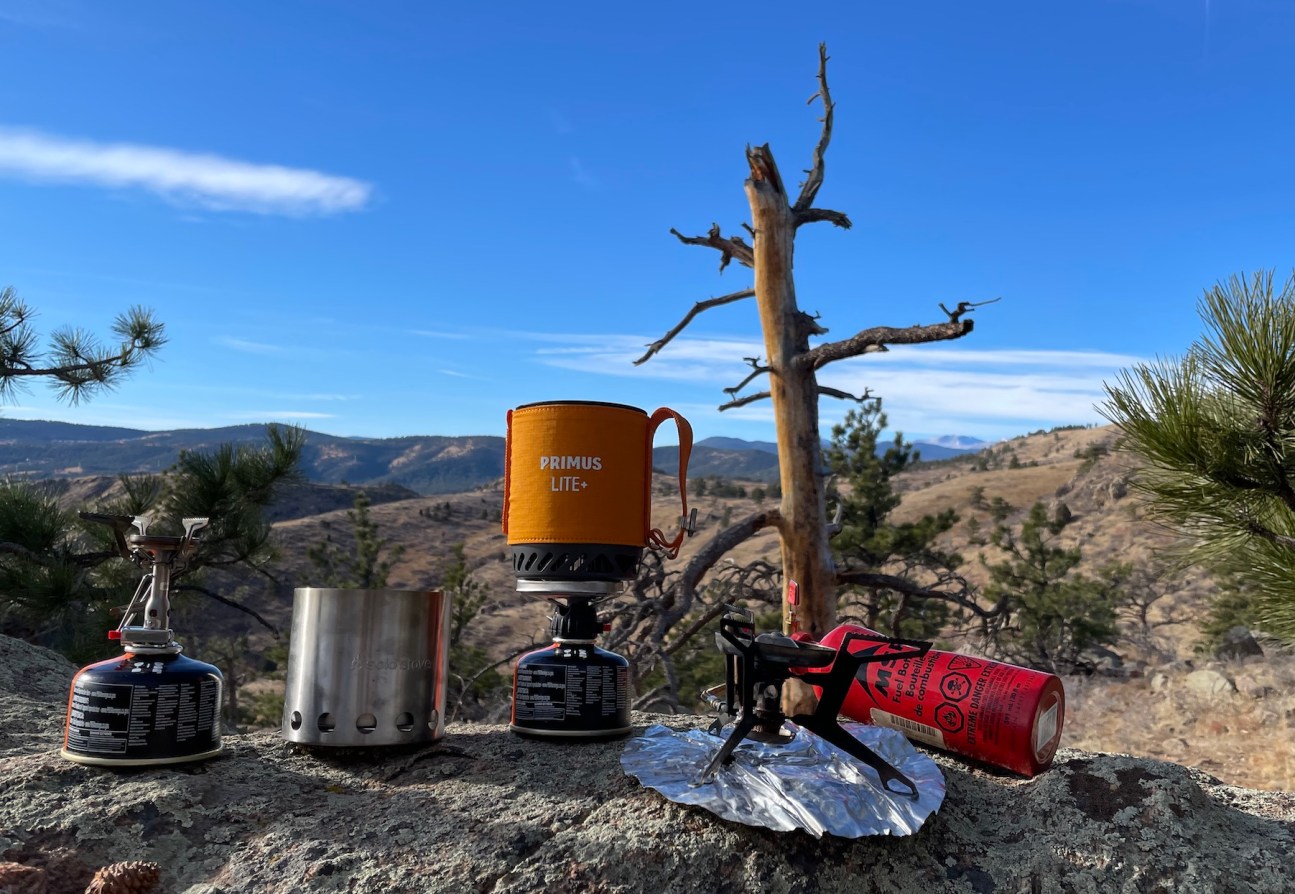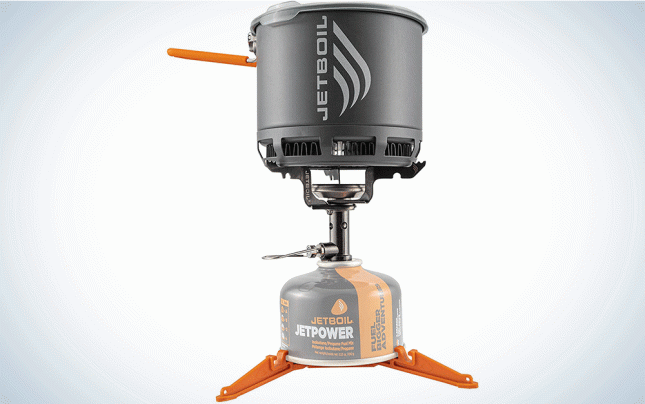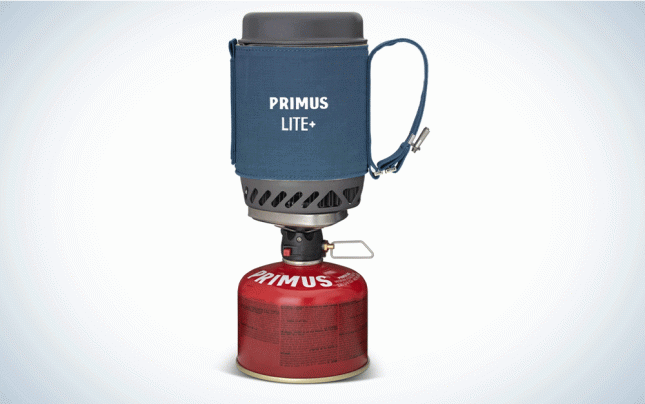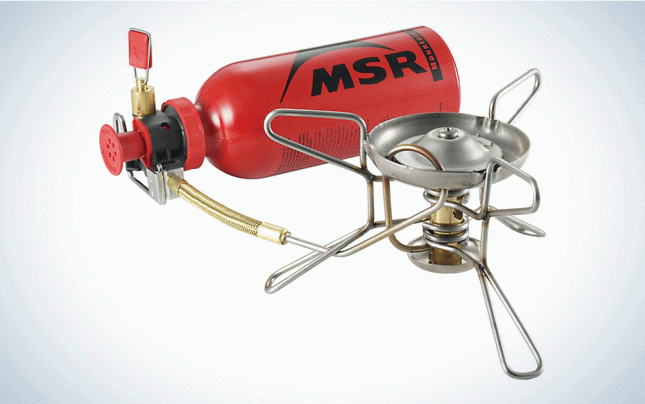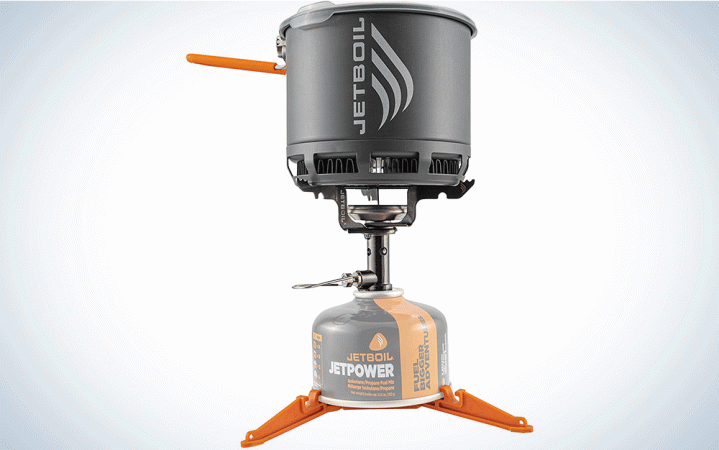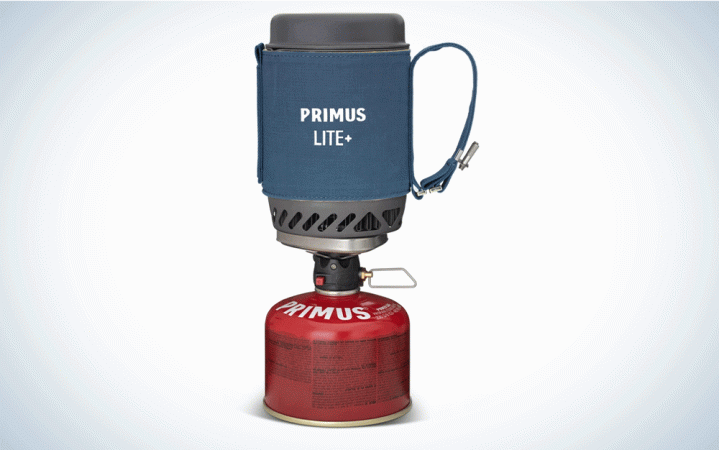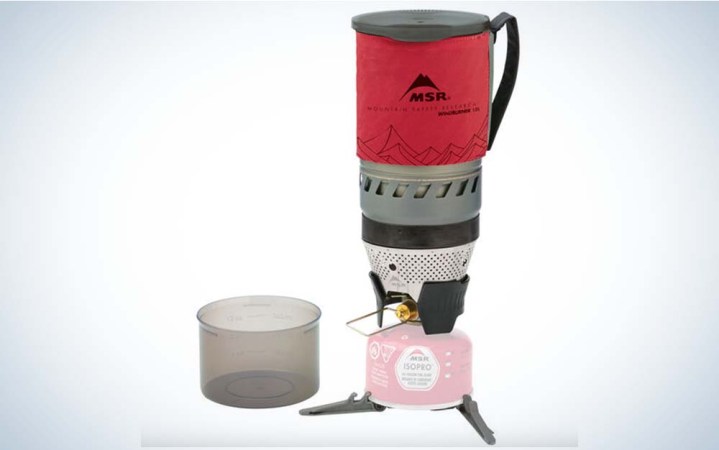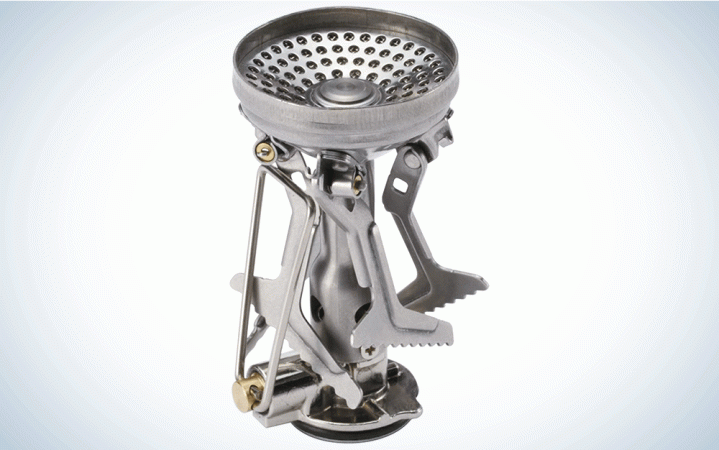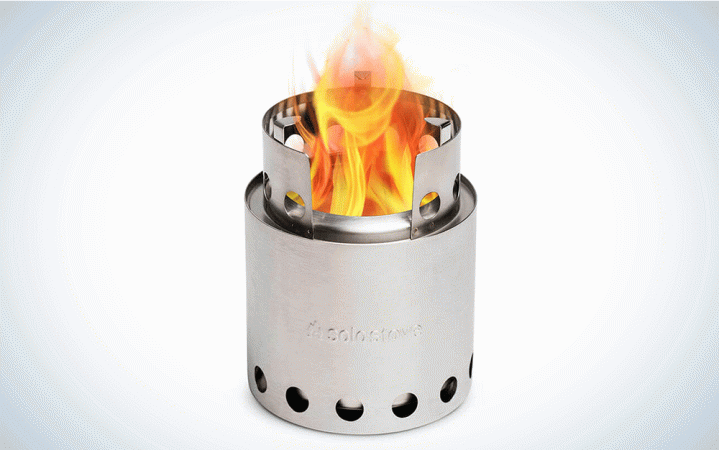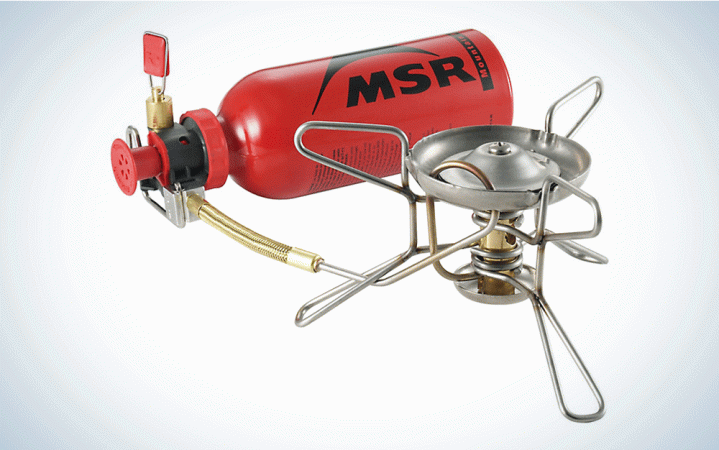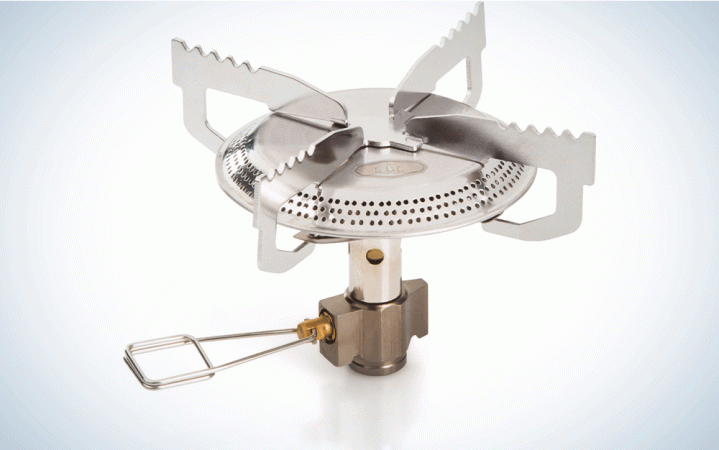We may earn revenue from the products available on this page and participate in affiliate programs. Learn More ›
When you look at the difference between a backpacker’s pack from 20 years ago, including what backpacking stove they carried, and today, you might be shocked by how light and compact modern gear is. Everything keeps getting lighter, better, more efficient. This definitely shows in the camp kitchen. The backpacking stove has evolved from heavy, bulky, and often finicky contraptions, to simple, light, and reliable designs. But still, not all of the best backpacking stoves are the same, and the right one for you probably depends on where and how you’re traveling.
- Best for Individuals: Jetboil Stash
- Best for Groups: Primus Lite+ (with Lite XL Pot)
- Best Windproof: MSR WindBurner
- Best Lightweight: Soto Amicus
- Best Wood Fuel: Solo Stove Lite
- Forever Pick: MSR Whisperlite
- Best Budget: GSI Glacier Camp Stove
Since my first backpacking trip when I was 14, I’ve been searching for my favorite backpacking stove, and have settled on this list for the most current market. All of these stoves are portable and user friendly, and I have confidence in recommending them to anyone shopping for their next trip (see my in-depth methodology and selection process at the end of this article).
How I Tested the Best Backpacking Stoves
Because of the variety of backpacking stoves on the market, I tested stoves that fell under the following categories:
- Liquid-fuel stoves
- Compact gas stoves
- Non-traditional/wood-burning stoves
- Cooking systems/stove kits (either liquid fuel or gas)
Then, I evaluated them on the following criteria:
- Ease to set up
- Weight without fuel, weight with recommended fuel
- What fuel it takes
- Ease to pack (Is it fragile? Is it bulky or is it compact?) (For kits, can it contain all of its own parts?)
- How big of a pot/pan can the stove confidently hold while cooking/how many people can a stove kit feed?
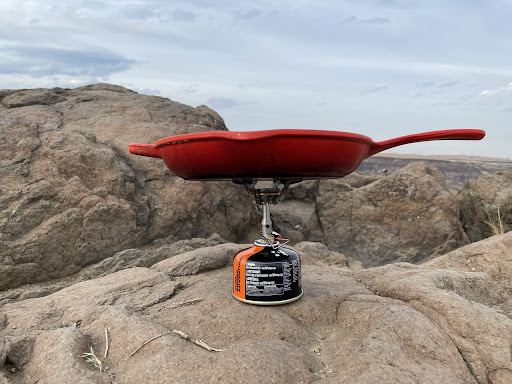
Because not all stoves are meant for the same pots, same amounts of water, and feeding the same people (including different volumes of stove kits), instead of timing every stove boiling the same amount of water in potentially different vessels, I boiled water in a full stove kit’s pot or 5 cups of water in a Stanley backpacking pot and noted above if any stove excelled or fell behind in the boiling process. No note of the stove’s boiling performance means it performed very well and on par with the rest of the stoves on this list.
Read Next: The Best Alcohol Stoves
Finally, after going through this testing, I awarded stoves to a category that realistically reflects when and why I’d pick each one for a backcountry trip.
Best Backpacking Stoves: Reviews & Recommendations
Best for Individuals: JetBoil Stash
Key Features
- 7.1-ounce stove system (with a 0.8-liter cook pot)
- 40% lighter than any other Jetboil cooking system
- Ultracompact nesting design
Pros
- Ultra-compact design
- Boils quickly and efficiently for its weight
- Feels like it weighs nothing
Cons
- Ideal for boiling water, not cooking directly in the pot
- I am not confident with it in the wind, so I brought the WhisperLite’s windscreen (adds to overall weight)
- Foldable valve knob is flimsy
Jetboil is known for its ultra-efficient design and capability making it our choice for the best backpacking stove overall. So when I tested their 40% lighter Stash, I knew this was my new go-to for quickly boiling water day hikes and rehydrating meals on solo backpacking trips.
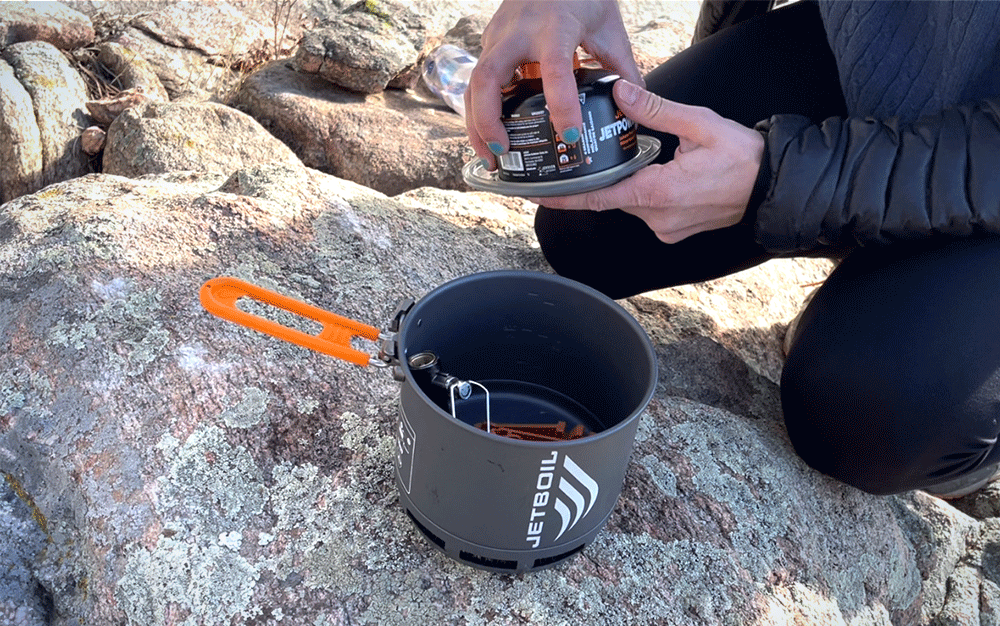
Let me reiterate that 7.1 ounces is nothing. It’s the same as carrying four extra Cinnamon Pop-tarts or an adult hamster. Ultralight backpacking keeps getting more accessible. Since I’ve only had this stove for the month of December, I’ve only taken it skiing or on day hikes, but come spring, this will be my go-to for packing light for one to two people. It boils 500ml of water in just 2.5 minutes, and the whole system—including a 100ml gas canister and a lighter—fits within the pot (Jetboil’s signature FluxRing technology increases the pot’s surface area to heat it faster and with less fuel).
Getting your pack as light as possible takes time and money, but this is a place to start. I’d recommend this kit for anyone packing lightly solo or in a pair, and who is mainly rehydrating backpacking food. I experimented cooking with other pots and pans on the stove, but the Stash pot is small and light enough to work perfectly without risking the stove falling over (meaning, if you’re buying this “cooking system,” use the stove and the pot together to get the full benefit).
Best for Groups: Primus Lite+ (with Lite XL Pot)
Key Features
- Weight: 14.1 ounces (approximately 35 ounces including fuel and the Lite XL Pot)
- Automatic ignitor
- Stove clicks into compatible pots
- Supports non-Primus cookware
Pros
- Easy assembly
- Instant ignite
- Comes with pegs to attach to stove to support non-compatible pots/pans
- Compatible accessories
- Fuel and stove pack into Lite-compatible pots
Cons
- Tough to unlock the pot from the stove/fuel while the stove is still hot
- Hard to cook with non-Primus pots if you lose the pegs

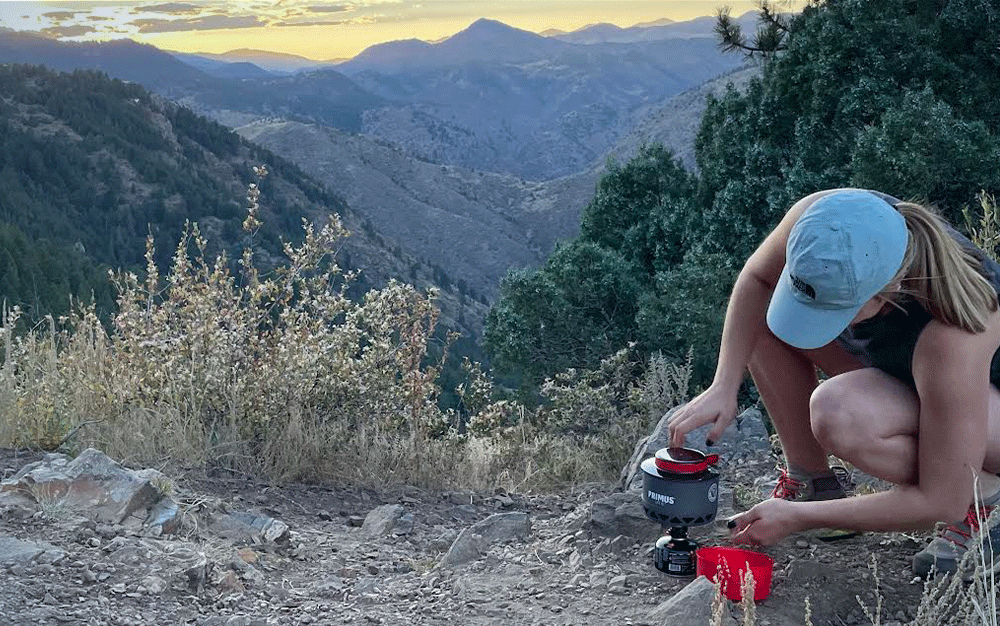
The Primus Lite+ Backpacking Stove System is pretty much everything I want for a backpacking trip. The more compact the better, and while it’s not the lightest stove or stove system on this list, it’s certainly not heavy, and I’m impressed with the quality of the small and Lite XL pots. Especially with a group of two or more, I’ll never leave without both components. What’s super unique about this system is that the stove directly snaps into the pots, keeping the flame as close as possible to the pot (which, like the Jetboil Stash, has a ribbon-like bottom to increase heated surface area). I do get nervous, however, when you have to rely on a stove’s instant ignite feature, but it’s proven to be reliable thus far (and you can manually light it when something isn’t snapped in.
I’m patiently waiting for Primus to come out with a pan that clicks into the Lite, because then it would really become my go-to stove.
Best Windproof: MSR WindBurner
Key Features
- Compact nesting design
- Compatible with other WindBurner cookware
- 15.3 ounces
- Wide burner and enclosed design to protect from harsh weather conditions
Pros
- Boils exceptionally fast
- Enclosed burner great for varying weather conditions
- Compatible with other WindBurner cookware
Cons
- No instant ignite for lock-on pot, so you have to lock on the pot while the flame is going
The WindBurner is light, easy to use, and compact. But unlike other backpacking stoves, it utilizes a wide burner that heats up the bottom of the pot quickly and has a shield around it, so its flame is harder to put out. This reason makes it my first choice for winter camping. I tested the stove in -10 degrees, and it still lit, kept a flame, and boiled a liter of water in under 6 minutes (barely slower than its standard boil time). Not only is the flame protected from the wind, but also the stove’s sturdy base gives me confidence the setup won’t fall over due to a big gust of wind.
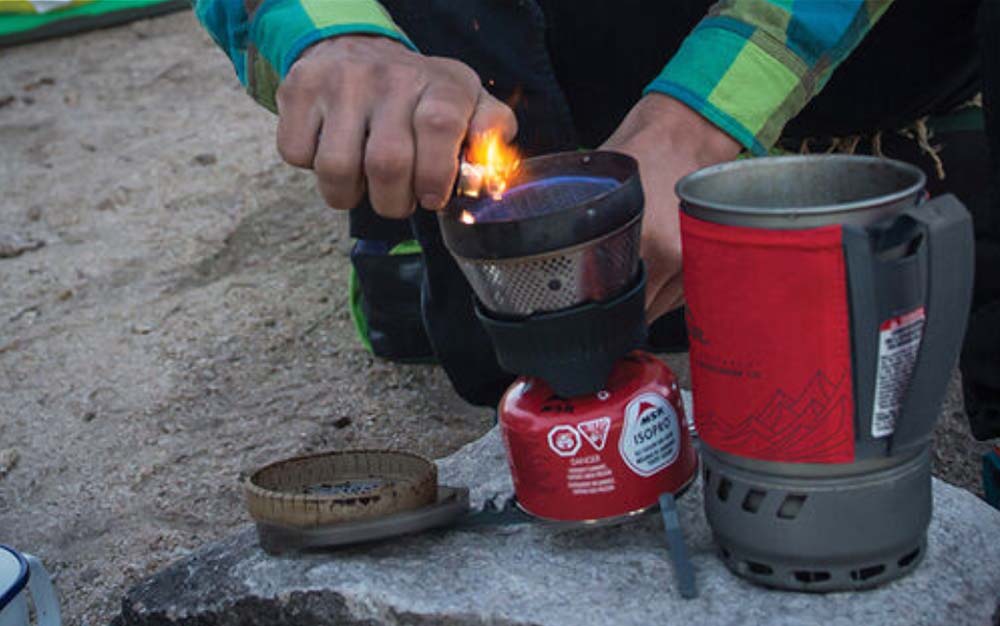
While the WindBurner comes a liter pot for boiling, there are a range of WindBurner accessories that are more conducive to group cooking, making it even more versatile.
Best Lightweight: Soto Amicus
Key Features
- Weight: 2.9 ounces
- Compatible with all major gas canisters
- Fits in the palm of your hand
- Instant ignite
Pros
- Small and lightweight
- Can support a large cast iron skillet
- Great option so you never carry weight you don’t need—can easily carry more than one as a backup (as you should)
Cons
- Not ideal for a larger group
- Have to make sure it doesn’t get buried by your pack and the legs don’t get crushed
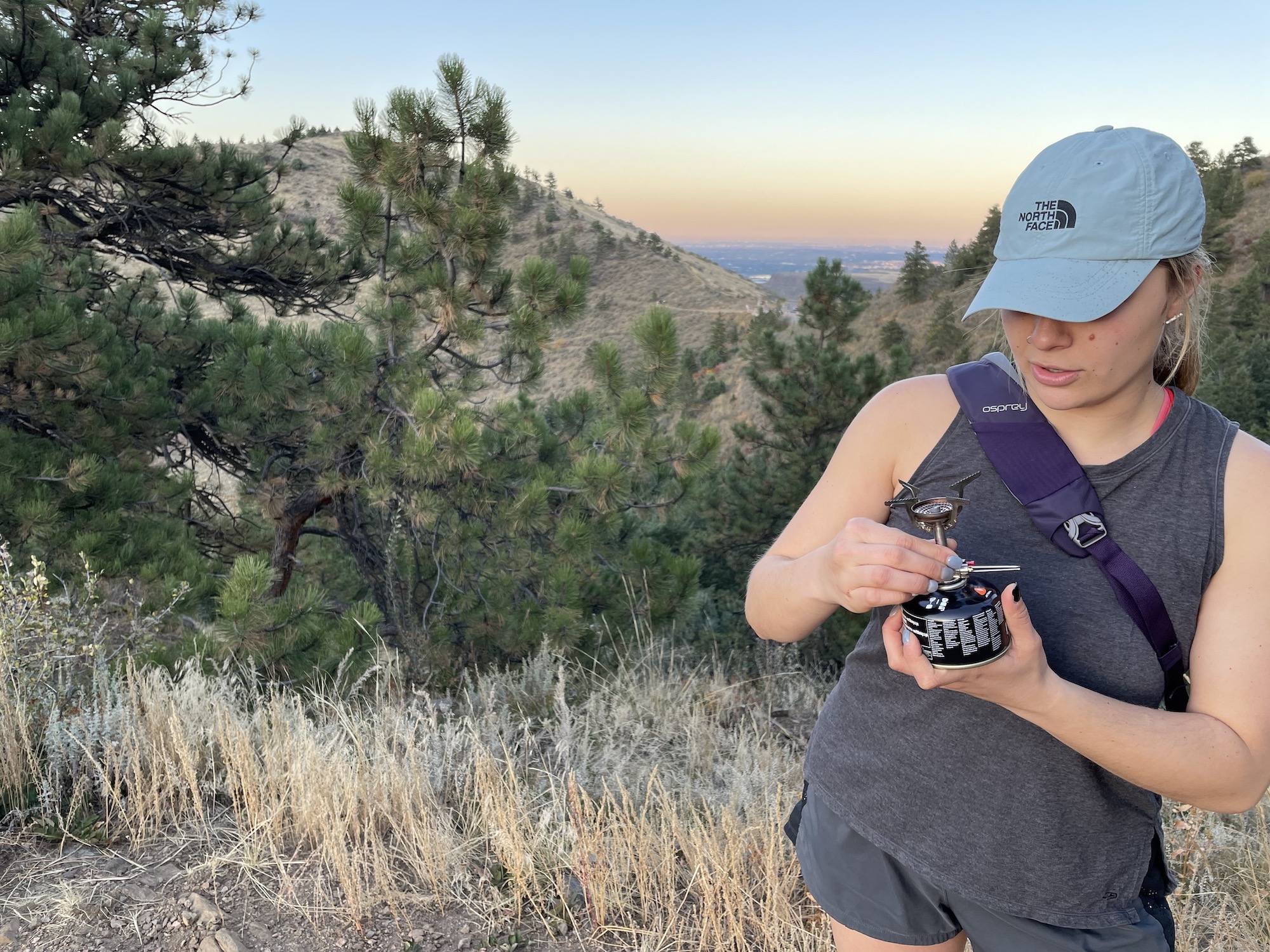
This ultralight stove is my first choice for anyone looking to cut back on weight while still packing top-tier gear. At only 2.9 ounces, packing a backup—or two—is still lighter than some options on this list. While it feels shaky under larger pots, for a solo backpacker or a pair, the Amicus will easily support a small, lightweight pot (my 20oz Stanley pot is as large as I’m willing to go). While the Jetboil Stash’s actual stove is lighter than the Amicus, this would be my go-to to supporting heavier pots and pans. I trust this tiny stove a lot.
It’s easy to set up, and its instant ignition makes it easy to light. In my test, it boiled 5 cups of water in under 5 minutes, making it competitive with any stove on this list. Just make sure you test all your cookware on the Amicus before your trip and keep it at the top of your pack.
Another great lightweight backpacking stove: MSR PocketRocket 2
Best Wood Fuel: Solo Stove Lite
Key Features
- Weight: 9 ounces
- No gas needed; fueled by sticks, twigs, and grass
- Stainless steel
Pros
- No waste generated from gas canisters
- Stays hot when fueled consistently
- Lifetime warranty
Cons
- Gas keeps a more consistent flame than a fire
- Fire leaves a residue on your pot or pan
- Check with local jurisdictions about fire bans and whether local rangers consider the Solo Stove Lite an open flame
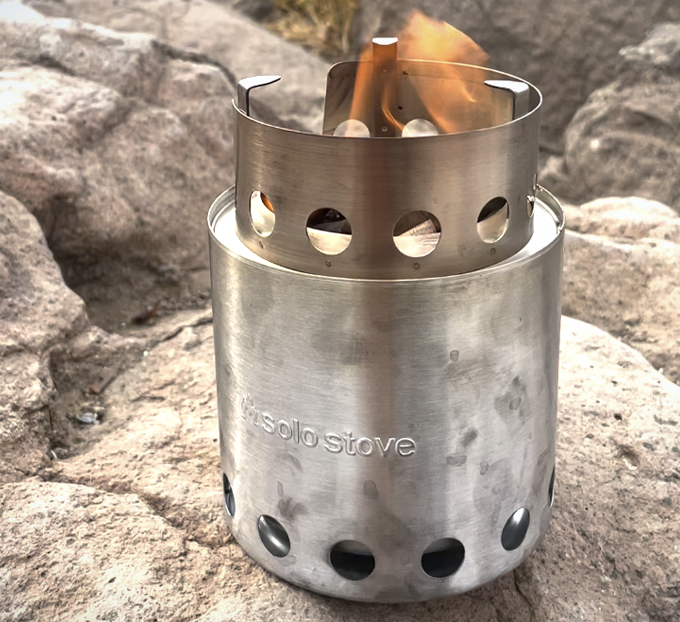
The Solo Stove Lite is a unique iteration of Solo’s fire pits. It runs on just sticks and twigs, maintaining an impressive flame with minimal smoke. While this stove is light, sustainable in the sense that it does not burn fuel or waste canisters, it’s important to be aware of your destination’s fire restrictions. Solo does not have a direct statement about whether or not their Lite constitutes as a stove or fire pit (cooking stove vs. an open flame), so do your research heavily.
If you are going out for a night or two in a low fire danger area, then a backup may not be necessary. That being said, for longer treks in the West where fire bans are common and unpredictable throughout the summer and fall, this stove may not be for you at the risk of a Stage 1 or 2 ban being implemented without your knowledge.
Forever Pick: MSR WhisperLite
Key Features
- Includes stove, fuel pump, windscreen/heat reflector, small-parts kit, instructions, and stuff sack
- Refillable white gas bottles
- 9.5 ounces (not including fuel bottle)

Pros
- Longevity
- Possible to fix in a backcountry setting
Cons
- Heavier than newer technologies
- It has a lot of parts and you need to learn how to set it up and prime it
- You have to manually pump fuel
I have had my WhisperLite since 2014, and there’s never been a single issue (and I’ve put it through a lot) that I haven’t been able to easily and intuitively fix in the backcountry. I firmly believe it to be the most reliable piece of backpacking gear I will likely ever own. While most recent stoves have a fuel canister you use as the base of the stove, the WhisperLite uses a refillable canister of white gas, which you can throw in the side pockets of your pack and whose fuel levels are easy to gauge.
What continues to stand out to me about this stove—and why I often pick it over newer, fancier models—is how confident I am that it won’t break on me, and if it does malfunction, that I’ll be able to repair it with ease. One summer working for my college’s outdoor education department, I had to take apart, clean, and reassemble 50+ backpacking stoves, and while it took days to fully get the smell of white gas on my hands, it was a relatively simple task.
To put it plainly, I trust this stove. It’s easy to control the amount of fuel going into the stove with the fuel pump, is strong enough to hold a variety of different pots and pans, and I’ve never been worried about it getting crushed in my pack. Read any review of the MSR WhisperLite and you’ll see a community of people who have been loving this stove since the 90s. I know mine isn’t going anywhere anytime soon.
Best Budget: GSI Outdoors Glacier Camp Stove
Key Features
- Weight: 5.9 ounces
- Compatible with all major gas canisters
- 5-inch diameter
- Coleman-like burner with supports for larger pots
- Lifetime warranty
Pros
- Inexpensive
- Supports large pots and pans
- Simple design
Cons
- Doesn’t fold up
- Valve doesn’t regulate gas well
- Metal tabs holding arms are easily bent
The GSI Glacier is a large burner-style backpacking stove that can support wide heavy pots. It is a full burner that is relatively light for its capacity and great for feeding big groups. It’s compatible with any standard isobutane gas canister, and keeps a pretty consistent flame across its burner. That being said, if you’re backpacking light and have smaller pots and pans, you might be looking for a smaller diameter so the flame sits under your pot.
It has a boiling power similar to the other, more expensive stoves on this list, but is less competitive when it comes to its construction. One of the metal tabs under the stove got bent in my backpack, causing one of the arms to get loose (I am worried that in a few more trips, the metal guard underneath may fall off). But for under $30, I’m impressed with its performance, and gave one as a gift this year for the holidays.
How to Choose the Best Backpacking Stove
When choosing your best backpacking stove, you want to first plan your trip’s length and destination, figure out how many people are coming, and make your ideal (but realistic) menu for the trip. After that, you’ll have an idea of just how many cooking vessels you’ll need, and how to balance the ratio between weight and convenience. For example, if it’s just two of you for a weekend and you only plan to use a stove for oats and dehydrated dinners, you’ll want to prioritize a lightweight stove that boils quickly. But if you have three or four people for a longer trip and you’re looking to cook more intricate meals, you’ll want more than one pot/pan and potentially sturdier stoves.
Similarly, consider the type of terrain you are headed out into. If it’s going to be especially windy, you’ll want to pick an option that won’t lose its flame in a stiff breeze. And if it’s an area that has certain restrictions on fuel, check what those are before purchasing a stove.
If you’re new to backpacking, it’s typically best to stick with the easiest form of stove, rather than the more complicated white gas stove versions like the MSR Whisperlite.
FAQs
Yes. Always. Even if you’re just going on an overnight and don’t plan to cook, a stove is a lot more than a hot meal. If, for any reason, your water purification system fails, you need to be able to boil water. Additionally, from a first aid perspective, you need ample clean water to irrigate a wound, and warm water bottles on someone’s hands, chest, and feet are recommended in treating hypothermia.
This is a tough question, so better be safe than sorry. One full 100g canister is going to last around one litre of water, so if you’re trying to pack as light as possible, plan your meals ahead and think about how many boils/how much cook time you’ll need for your meals. Call it one canister for a weekend trip per person, and then round up in case of an emergency.
I would always advise a backup stove, especially for how light and compact stoves have gotten. Especially if your stoves all use the same standard fuel cans, how much weight is it really costing you to throw an Amicus and a little backup fuel into your first-aid kit? And with a group, it’s always convenient to have a stove for simultaneously boiling water and cooking. (Even then, I would keep an emergency stove protected and tucked away.)
Why Trust Outdoor Life?
Since 1898, OL has been a leading authority in testing and reviewing hunting gear, fishing tackle, guns and shooting equipment, and much more. We have more than a century-long history of evaluating products, and we’re now bringing that expertise to online reviews. Our editors are experienced outdoorsmen and women, and most importantly, we’re trained journalists. We prioritize field testing and objective data when reviewing products. We conduct interviews with gear manufacturers and engineers as well as outdoor experts so that our readers have an understanding of how and why a product works—or doesn’t.
Advertising does not influence our gear reviews and it never will. While we always focus our coverage on standout products—because we want our readers to be aware of the latest and greatest gear—we also cover the flaws and quirks of any given product.
Final Thoughts
With so many different stoves marketing new technologies and an updated model coming out nearly every year, you’re not missing out on still using a stove you bought when you were 17… I still pick my first WhisperLite over the latest and greatest for some trips. Because what matters is you have a stove that works, you’re confident in using, and you’re confident in fixing.
As I said above, a stove isn’t optional, even if you’re more of a pb&j kind of person. You need a means to purify water to drink and/or clean a wound. After all, a good meal and a reliable source of clean water will make or break your trip. So, you might as well treat yourself to a cup of coffee in the morning and become a backcountry chef if it barely weighs anything anyway.
- Best for Individuals: Jetboil Stash
- Best for Groups: Primus Lite+ (with Lite XL Pot)
- Best Windproof: MSR WindBurner
- Best Lightweight: Soto Amicus
- Best Wood Fuel: Solo Stove Lite
- Forever Pick: MSR Whisperlite
- Best Budget: GSI Glacier Camp Stove
